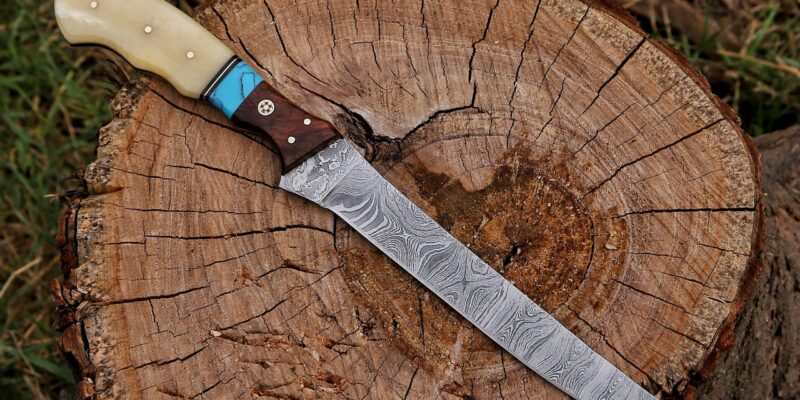
Japanese fillet knives, renowned for their precision and craftsmanship, blend centuries-old tradition with modern innovation to create some of the finest tools for fish preparation. In 2024, these knives continue to captivate chefs and home cooks alike with their superior sharpness, impeccable design, and cultural significance. Let’s delve into the secrets that make fillet knife a cut above the rest.
The Artistry of Japanese Knife Making
Japanese knife making is steeped in centuries of tradition, combining meticulous craftsmanship with a deep respect for materials and techniques. The art of forging Japanese knives, including fillet knives, involves several key aspects:
- High-Quality Steel: Japanese fillet knives often use high-carbon stainless steel or premium alloys like VG-10. These materials are known for their exceptional edge retention, allowing the blade to maintain sharpness through extensive use.
- Traditional Forging Methods: Many Japanese fillet knives are forged using traditional methods such as honyaki or kasumi. Honyaki knives are made from a single piece of high-carbon steel, providing unparalleled hardness and edge retention. On the other hand, Kasumi knives feature a blade made from high-carbon steel layered with soft iron, combining strength with flexibility.
- Hammering and Shaping: The process of forging Japanese knives involves skilled artisans hammering and shaping the steel to create a thin, precise blade. This meticulous craftsmanship ensures that each knife is functional and a work of art.
Unique Features of Japanese Fillet Knives
Japanese fillet knives are distinguished by several unique features that contribute to their superior performance:
- Thin and Sharp Blades: Japanese knives are renowned for their thin, razor-sharp blades. This allows for precise cuts with minimal resistance, ideal for intricate filleting tasks where precision is paramount.
- Katana-Inspired Design: Many Japanese knives draw inspiration from traditional katana swords. This influence is seen in the graceful curve of the blade and the attention to balance and control, making Japanese fillet knives a joy to use.
- Traditional Handles: Handles of Japanese fillet knives are often made from natural materials like wood (such as Japanese magnolia) or horn. These handles are designed to provide a comfortable grip and complement the blade’s aesthetic.
Innovation in Japanese Fillet Knives
While rooted in tradition, Japanese fillet knives also embrace innovation to meet modern culinary demands:
- Modern Alloys and Coatings: Some contemporary Japanese knives incorporate modern alloys and coatings to enhance durability and corrosion resistance while maintaining the traditional craftsmanship.
- Ergonomic Handles: Recognizing the importance of comfort and control, newer Japanese fillet knives may feature ergonomic handles made from modern materials like resin or composite, offering a secure grip even when wet.
- Specialized Designs: Manufacturers are continuously refining the design of Japanese fillet knives to cater to specific filleting techniques and fish types. This includes variations in blade lengths, shapes, and flexibilities to optimize performance.
Choosing a Japanese Fillet Knife
When selecting a Japanese fillet knife, consider the following factors:
- Blade Type: Decide between honyaki or kasumi blades based on your preference for hardness and flexibility.
- Blade Length: Choose a length that suits the size of fish you commonly prepare. Longer blades are ideal for larger fish, while shorter blades offer more control for intricate cuts.
- Handle Material: Consider the handle material that feels most comfortable and secure in your hand. Traditional wooden handles offer a classic look and feel, while modern materials provide durability and grip.
- Maintenance: Japanese knives require proper care and maintenance to preserve their sharpness. Regular honing and occasional sharpening on a whetstone are essential to maintain peak performance.
Tradition of Japanese Knife Making
Japanese knife making dates back centuries and is steeped in cultural heritage. The art of crafting Japanese fillet knives involves meticulous techniques passed down through generations:
- Forging Methods: Traditional Japanese fillet knives are often forged using methods like honyaki or kasumi. Honyaki knives are crafted from a single piece of high-carbon steel, offering exceptional hardness and edge retention. Kasumi knives feature a blade made from high-carbon steel layered with softer iron, providing a balance of strength and flexibility.
- Blade Construction: The blades of Japanese fillet knives are renowned for their thinness and sharpness. Craftsmen use hammering and shaping techniques to create blades that effortlessly glide through fish, ensuring clean cuts with minimal waste.
- Handle Materials: Handles traditionally use natural materials such as Japanese magnolia wood or horn. These materials are chosen not only for their aesthetic appeal but also for their ability to provide a comfortable grip and balance to the knife.
Innovation in Japanese Fillet Knives
While rooted in tradition, Japanese fillet knives embrace modern innovations to meet the demands of contemporary chefs and home cooks:
- High-Quality Alloys: Modern Japanese knives often incorporate high-carbon stainless steel or premium alloys like VG-10. These materials enhance edge retention and corrosion resistance, prolonging the knife’s lifespan and maintaining sharpness.
- Ergonomic Designs: Manufacturers have introduced ergonomic handle designs made from modern materials like resin or composite. These handles improve grip and comfort, particularly during prolonged use, without compromising on the knife’s balance or aesthetic.
- Specialized Blade Features: Variations in blade lengths, shapes, and flexibilities cater to different filleting techniques and fish types. This customization allows chefs to achieve precise cuts tailored to their culinary preferences.
Choosing the Right Japanese Fillet Knife
When selecting a Japanese fillet knife, consider the following factors to ensure it meets your specific needs:
- Blade Type: Decide between honyaki or kasumi blades based on your preference for hardness and flexibility. Honyaki knives offer superior hardness, while kasumi knives provide a balance of strength and flexibility.
- Blade Length: Choose a blade length that suits the size of fish you frequently prepare. Longer blades are ideal for larger fish, whereas shorter blades offer more control and precision for smaller species.
- Handle Comfort: Evaluate the handle material and design for comfort and grip. Traditional wooden handles provide a classic feel, while modern materials offer durability and ergonomic benefits.
- Maintenance: Japanese knives require proper care to maintain their sharpness. Regular honing and occasional sharpening using a whetstone are essential to preserve the knife’s cutting edge and performance.
Embracing Tradition and Innovation
Japanese fillet knives represent more than just tools; they embody a cultural legacy of craftsmanship and precision. Whether you’re a professional chef striving for perfection or a home cook passionate about culinary excellence, investing in a Japanese fillet knife unlocks a world of culinary possibilities. Explore the artistry, tradition, and innovation behind these exceptional knives, and elevate your fish preparation to new heights in 2024 and beyond.
Conclusion
Japanese fillet knives represent the pinnacle of knife-making craftsmanship, blending ancient traditions with modern innovations to create tools that are as functional as they are beautiful. Whether you’re a professional chef or a passionate home cook, investing in a Japanese fillet knife unlocks a world of precision and artistry in fish preparation. With their razor-sharp blades, ergonomic designs, and cultural significance, these knives continue to set the standard for excellence in culinary tools. Embrace the tradition and innovation of Japanese fillet knives, and elevate your seafood dishes to new heights of flavor and presentation in 2024 and beyond








